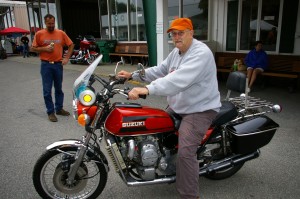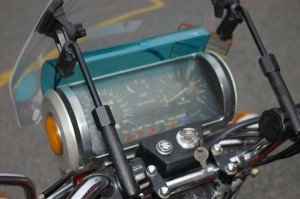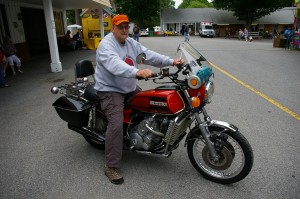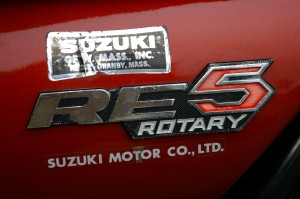By Bud Wilkinson of RIDE-CT.com
The futuristic Suzuki RE-5 motorcycle was enthusiastically described in a promotional video as “a touring machine of a new age” and touted as being “in perfect harmony with  the serene beauty of nature.” Riders back in the mid-70s thought differently. They not-so-serenely viewed the RE-5 as a freak of nature, an oddity not worth the cash. Consequently, the RE-5 only lasted for the 1975 and 1976 models years, with approximately 6,200 sold worldwide. Not surprisingly, the bike that nearly brought down Suzuki is now a collectible.
the serene beauty of nature.” Riders back in the mid-70s thought differently. They not-so-serenely viewed the RE-5 as a freak of nature, an oddity not worth the cash. Consequently, the RE-5 only lasted for the 1975 and 1976 models years, with approximately 6,200 sold worldwide. Not surprisingly, the bike that nearly brought down Suzuki is now a collectible.
What makes the RE-5 memorable are its tin can instrument cluster, its lollipop turn signals and its 497cc motor that has no pistons, no crankshaft and no camshaft. But it does  have two cooling systems and air intake ports built into the front of the exhaust pipes to cool them. The single word “ROTARY” beneath the model designation on the bike’s side covers tells the story. It doesn’t have a reciprocating engine, rather a Wankel power plant. That’s the type that carmaker Mazda once advertised went “Hmmmmmm” instead of “boing, boing, boing.”
have two cooling systems and air intake ports built into the front of the exhaust pipes to cool them. The single word “ROTARY” beneath the model designation on the bike’s side covers tells the story. It doesn’t have a reciprocating engine, rather a Wankel power plant. That’s the type that carmaker Mazda once advertised went “Hmmmmmm” instead of “boing, boing, boing.”
It does sound different. If a present-day sport bikes exhibit a high-pitched whine, the RE-5 has more of a whirr. “It sounds like a P-51 Mustang. When the revs come up, it sounds like it has a lot of cylinders,” said RE-5 owner Mark Menard of South Hadley, Mass. after RIDE-CT located him down at the Rhinebeck Grand National Meet at the Duchess County Fairgrounds in New York.
Menard’s orange 1975 RE-5 was part of a “Timeline” at the vintage event and it certainly attracted attention among the motorcycle cognoscenti. Among the admirers was Jerry Havenhill of Independence, Mo., who owns two RE-5s, a 1975 and a 1976. “They’re beautiful. They’re smooth as glass, but they’re a bitch to ride,” he said, noting that they are top-heavy.
Finding Menard required the help of a security guard who assisted me in spotting a secreted microphone for the public address system. I grabbed the mike, flipped the switch  to “on” and firmly intoned, “Mark Menard … Please report to your bike on the Timeline. Mark Menard … Please report to your bike on the Timeless.” That announcement predictably made him worry if something had happened to his bike, but it brought him quickly.
to “on” and firmly intoned, “Mark Menard … Please report to your bike on the Timeline. Mark Menard … Please report to your bike on the Timeless.” That announcement predictably made him worry if something had happened to his bike, but it brought him quickly.
Menard has owned the bike for four years. “The price was good. It was different. I kinda liked it,” he said, revealing he paid only $500 to Allpower, the Suzuki dealer in Granby, Mass. That was before riders started viewing the Wankel as wonderful. While the RE-5 originally sold for $2,475, and could be picked up for as little as $900 as a new leftover at Allpower after Suzuki stopped making them, today it fetches from $4,000 to $7,000. A non-running blue 1975 RE-5 spotted elsewhere on the grounds at Rhinebeck had a price tag of $3,500 or so.
The RE-5 that Menard bought was in good running order, having been dumped on the  dealer by its original owner after he heard what it would cost to restore the bike to showroom condition. “It needed some work. It needed some cosmetic stuff,” Menard said, recalling that he repainted the factory hard bags black from the original matching orange and cleaned up some oxidation. He agreed with assessment that the bike can be a handful. “It’s heavy,” he said. “It’s not fuel efficient.” The listed weight is 507 pounds and gets about 40 mpg.
dealer by its original owner after he heard what it would cost to restore the bike to showroom condition. “It needed some work. It needed some cosmetic stuff,” Menard said, recalling that he repainted the factory hard bags black from the original matching orange and cleaned up some oxidation. He agreed with assessment that the bike can be a handful. “It’s heavy,” he said. “It’s not fuel efficient.” The listed weight is 507 pounds and gets about 40 mpg.
Although the RE-5 was available for a scant two years, there are differences between the 1975 and 1976 models. The 1975 or “M” model came with the cylindrical instrument pod with a tinted cover and a matching tail light. They certainly are eye-catching, especially the instrument panel. “I get some guys who are amazed at that thing,” said Menard. The 1976 or “A” model featured more traditional side-by-side speedometer-tachometer gauges and less noticeable tail light and turn signals. In fact, the gauges and other fixtures were reportedly shipped to dealers so they could transform existing 1975 bikes into 1976 models.
Despite its shortcomings, Menard does like the RE-5. “I do enjoy riding it. I like an upright sitting position. To me, it comfortable to ride for a long distance,” he said.
It’s easy to understand why Suzuki’s rotary motorcycle didn’t revolutionize the industry, and why the failure of the RE-5 almost did in Suzuki. After investing heavily in technology to get the RE-5 to the production stage, the company then built an entire factory just to assemble the RE-5. “They never really sold,” said Menard. “Now, there’s a definite following.”
(Originally published in “The Republican-American” on June 18, 2011.)
 Ride CT & Ride New England Serving New England, NYC and The Hudson Valley!
Ride CT & Ride New England Serving New England, NYC and The Hudson Valley!

